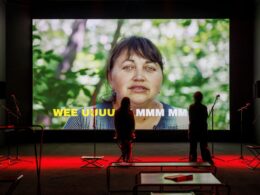An array of never-seen-before artworks and morefamiliar ones by artist Victor Pasmore is being showcased in an exhibition that examines his relationship with the Maltese Islands through the various characteristics, mediums and materials he utilised during the final three decades of his life.
The artwork Pasmore created during this period will be exhibited during The Eye & the Symbol, The Permanent Collection, at the Victor Pasmore Gallery at APS House in St Paul Street, Valletta.
Pasmore is regarded as one of the most prominent figures of the modern art movement of the 20th century both locally and internationally.
During the three decades he spent living in Malta, he underwent an artistically experimental phase, producing some of his most notable work.

Pasmore tirelessly sought to present his art as a creation that was not restricted by a sense of place and time.
However, it is possible that being so close to Malta’s primitive and ancient past may have subconsciously awakened untapped aspects in the artist’s mind, creating a quasi-nostalgic abstraction of place, space and time within his later work.
In 1966, Pasmore and his wife, Wendy, moved to Malta and chose a secluded farmhouse in Gudja as their permanent residence. This provided Pasmore with the closed confines he craved to develop new art forms and rediscover light and colour.


While living in Malta, Pasmore used the many hardware stores around the island to regularly source materials to create his abstract works.
While living in Malta, Pasmore used the many hardware stores around the island to regularly source materials to create his abstract works.
“What, perhaps, is relevant to my new painting in Malta is that the close and constant proximity of the ancient, mythological and Neolithic past has reinforced my orientation from the physics of art to its biological and psychological content,” Pasmore had said in 1972.
The Victor Pasmore Foundation was set up in July 2012 by Pasmore’s wife and his two children, John and Mary Ellen (Nice), to conserve and promote his work as a significant testimony to 20th-century art.
In 2014, the Central Bank of Malta agreed to permanently host Pasmore’s work at the Polverista Gallery in Valletta.
Fondazzjoni Patrimonju Malti took over the collection’s management the following year, bringing to light the Maltese modern art movement and Pasmore’s influence on its direction.
In 2020, further to an agreement with the Victor Pasmore Foundation, FPM became the custodians of the artworks.
In 2021, the foundation transformed the former APS headquarters in Valletta into a state-of-the-art gallery that would house the Victor Pasmore collection.
Nowadays, FPM manages the Victor Pasmore Gallery, which seeks to preserve the artist’s legacy through an engaging range of exhibitions, events and programmes showcasing his work and that of his Maltese peers.
The gallery is also dedicated to researching, assisting and participating in the realisation of further studies into Pasmore’s work. Its inaugural exhibition, In Search of Line, which closed in March, showcased the institution’s aim to explore new ways of engaging with 20th-century Maltese art and offered a taster of future projects.
The Victor Pasmore Gallery is open from Tuesdays to Thursdays between 10am and 5pm (last entry at 4pm); on Fridays between 2pm and 7pm (last entry at 6pm); and on Saturdays between 10am and 3pm (last entry at 2pm). Tickets can be purchased at the door.










